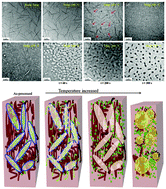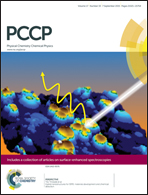Temperature-dependent nanomorphology–performance relations in binary iridium complex blend films for organic light emitting diodes†
Abstract
Understanding the mechanism responsible for the temperature-dependent performances of emitting layers is essential for developing advanced phosphorescent organic light emitting diodes. We described the morphological evolution occurring in PVK:Ir(ppy)3 binary blend films, with respect to thermal annealing up to 300 °C, by coupling atomic force microscopy and transmission electron microscopy. In particular, in situ temperature-dependent experimental characterization was performed to directly determine the overall sequence of morphological evolution occurring in the films. The device thermally annealed at 200 °C exhibits a noticeable enhancement in the performances, compared to the devices in the as-processed state and to the devices annealed at 300 °C. Our approaches reveal that the Ir(ppy)3 molecules, with a needle-like structure in the as-processed state, were aggregated, and thus diffused into PVK without a morphological change at the temperature regime between 150 °C and 200 °C. Moreover, both network-like and droplet patterns existed in the devices annealed at 300 °C, which was beyond the glass temperature of PVK, leading to a profound increase in the surface roughness. The observed pattern formation is discussed in terms of viscoelastic phase separation. Based on our experimental findings, we propose that the performances of the devices are significantly controlled by the diffusion of dopant molecules and the morphological evolution of the host materials in binary blend systems.


 Please wait while we load your content...
Please wait while we load your content...